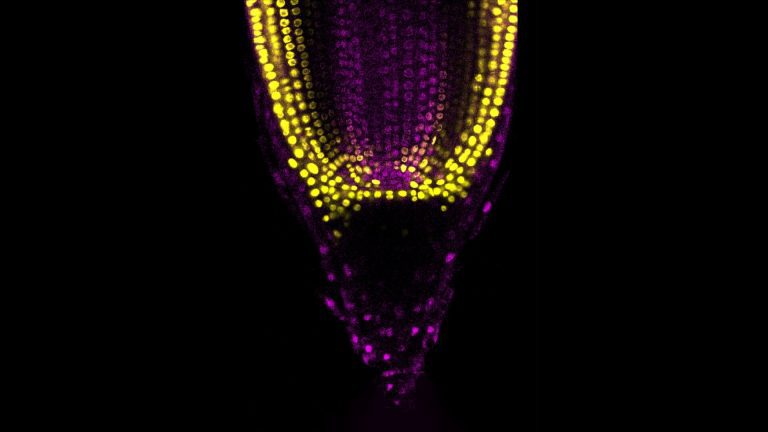
Raristem Root Meristem of Sorghum showing cell division. Credit: Crag
In a series of three recent studies, a team led by a CSIC researcher in Crag Ana I. Caño-Delgado has made significant progress in understanding molecular mechanisms and improving the reproduction of sorghum, the fifth most cultivated cereal in the world, which is particularly important in arid and semi-arid regions. The importance of this cereal lies in its role in the future of human and animal nutrition, offering a lasting alternative for areas faced with the shortage of water.
Sorghum is increasingly recognized as a staple in many regions of the world, including outside Africa, where it has been cultivated for centuries, due to its multiple nutritional advantages and its resistance to unfavorable climatic conditions. In Europe, the culture of sorghum is increasing and is promoted as an alternative to crop rotationEspecially in the regions subject to the water shortage.
The European Union actively promotes the cultivation of sorghum as a climate resilient harvest, with an increase of 57% of the total sorghum production in the last decade. France, in particular, is at the forefront of this trend with 103,000 hectares dedicated to the culture of Grains sorghum last year. Meanwhile, Spain is an important importer of sorghum in Europe, mainly for animal feed but with prospects for human food in the future.
In 2020, 158,000 tonnes were imported into Spain, therefore an increase in its culture in the territory could reduce dependence on imports. For reference, Spain has imported 303,000 tonnes of barley in the past six months, making it the third most imported culture.

On the left, Andrés Rico, first author of the study, and on the right Ana I. Caño-Delgado, who led the study. Credit: Crag
Crag scientific contributions
Crag’s research efforts are at the forefront of sorghum science, focusing on improvement, even more, its adaptability to stress conditions and improving its laboratory handling for future reproductive processes. Over the past 20 years, the research group led by Ana I. Caño-Delgado has been devoted to the study of this cereal and has received numerous subsidies, including an ERC POC from the European Research Council (ERC). In the past six months, the group has published three scientific articles of great importance for the sector.
In the First of all of these three studies, published in the Plant biotechnology Journal, the research team has identified that the mutations of the Bicolor Bicolor receiver from Sorghum Protein, SBBRI1, giving tolerance to drought by modifying the metabolism of phenylpropanoids. This discovery highlights a molecular mechanism to improve drought resistance in sorghum, a critical line for climate resilient agriculture.
A second work, published in The factory newspaperDetailed a significant progression of sorghum biotechnology: an effective sorghum transformation method using a ternary vector system combined with morphogenic regulators. Previous tools and methods were not effective enough to study certain sorghum varieties, posing an important challenge for scientists and breeders. This new protocol solves this problem by allowing a very effective transformation using Tumefaciens agrobacterium and allows the application of new reproductive techniques such as genes to accelerate the improvement of crops.
This technology provides a useful tool for creating and studying mutants of interest with very high efficiency in the transformation of recalcitrant sorghum (varieties resistant to genetic transformation), reaching a double increase in processing efficiency.

Sorghum plant. Credit: Crag
Juan B. Fontanet-Manzaneque, principal author of the two studies, underlined the importance of these breakthroughs in the culture of sorghum: “Our objective was to equip the sorghum community with advanced molecular tools to accelerate the reproduction of sorghum, but also some essential key target genes to develop cultures resistant to drought.”
The third study, published in the journal New phytologistCharacterizes the role of SBBRI1 in root development, in particular in the meristem region, connecting BRI1 to the metabolism of the cell wall and demonstrating that the SBBI protein of Sorghum plays a role functioning functionally in the growth and development of plants. The development of roots is crucial for the overall growth and the health of the plant and plays a role in the way the plant reacts to environmental stressors.
Andrés Rico-Medina, the first author of the study, underlined the technique implemented: “We have adapted the coloring and imaging protocols which are used in models like Arabidopsis to be useful for studies in sorghum.”
He also noted: “This adaptation is used to fill the gap between laboratory drought studies and a more agronomic context, thus facilitating the practical application of these scientific progress”.
Socio-economic and political implications
Sorghum is increasingly considered as a crucial culture for the adaptation of climate change due to its tolerance to high temperatures and drought, in particular compared to corn, which is the most cultivated cereal in Europe and is very sensitive to water stress. Studies show that the importance of sorghum in Europe should increase due to climate change.
In addition, the expansion of the culture of sorghum in Spain could create new economic opportunities for farmers, reducing dependence on imports and stimulating local agricultural production. In Catalonia, more than 100,000 tonnes of sorghum was produced in 2023, more than 90% of which were intended for animal feed.
In addition, sorghum is a naturally gluten -free cereal, a particularly relevant characteristic of the food industry. Its high adaptability and nutritional value make it a key culture to improve food security. The growing demand for sorghum for human consumption, with an increase of approximately 6% of demand in 2024, highlights its potential for improving nutrition, especially when research leads to new varieties of sorghum.
Ana I. Caño-Delgado, group leader, said: “This research represents an important opportunity for Crag to establish technology transfer projects, to encourage public-private collaboration and to highlight the excellent work of our researchers”
These three scientific progress by Crag researchers not only open the way to more sustainable and more productive sorghum Cultivation but also mark a critical advance in the next generation of the global challenges of food security and nutrition. In addition, this observation is relevant for other essential crops such as corn, wheat and rice, because they also contain signaling pathways. This creates an opportunity for intelligent climatic agriculture, with more resilient and lasting varieties.
More information:
Molecular and physiological characterization of the BRI1 mutants of the Brassinosteroid receptor in the two -color sorghum, New phytologist (2025). DOI: 10.1111 / NPH.20443
Juan B. Fontanet – Manzaneque et al, effective transformation of sorghum and corn using a ternary vector system combined with morphogenic regulators, The factory newspaper (2024). DOI: 10.1111 / TPJ.17101
Juan B. Fontanet – Manzaneque et al, non -targeted mutagenesis of the sbbri1 brainosteroid receptor gives tolerance to drought by modifying the metabolism of phenylpropanoid in the two -color sorghum, Journal of Plant Biotechnology (2024). DOI: 10.1111 / PBI.14461
Supplied by Center for Research in Agricultural Genomics (Crag)
Quote: Advancing Sorghum Science: A Drought-Résilient Crop for Agriculture’s Future (2025, March 13) Recovered on March 13, 2025 from https://phys.org/News/2025-03-Advancing-sorghum-science-deght-resient.html
This document is subject to copyright. In addition to any fair program for private or research purposes, no part can be reproduced without written authorization. The content is provided only for information purposes.


